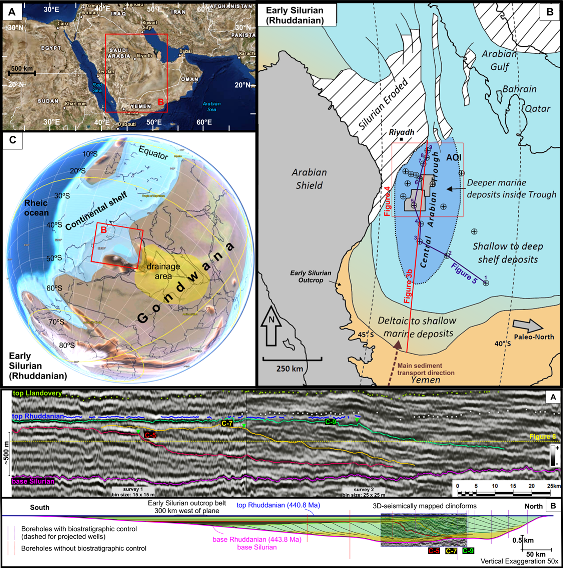Shelf-prism clinoforms in the pre-vegetation world
Early Silurian Shelf-Prism Clinoforms Progradation and Implications for Pre-vegetation Sedimentary Source to Sink Systems, a Case Study from Central Arabia
Research into this project has been holistic and multi-scale, I focused on all segments of the depositional system: catchment, shelf, slope and basin (with more emphasis on the latter two)

Objectives
- Evaluate Early Silurian (Rhuddanian) clinoforms and associated geomorphologies imaged on 3D seismic in detail using conventional seismic interpretation techniques as well as advanced seismic attribute methods.
- Convert seismic interpretation to depth as well as backstrip/decompact the Rhuddanian succession in order to appreciate the clinoforms size and compare them to other younger successions of the same scale, not just the size but progradation and sedimentation rates as well.
- Integrate borehole data (sedimentological, biostratigraphic, wireline logs) to subdivide the Rhuddanian succession into basin floor, slope, and shelf/deltaic broad segments. Also, use this data together with literature to constrain the Rhuddanian basin size.
- Study sediment provenance for this succession and determine the size of drainage, the availability of which allows for a source-to-sink statistical analysis and an indirect way to quantify Rhuddanian basin floor fans in central Arabia.
- Analyse deep water slope channels within the clinoforms and determine their fill and if rapid slope progradation and/or absence of land plants on the coeval alluvial plain had an effect in their evolution. Also, determine if their evolution had adverse effects on basin floor fan size/thickness.
- Evaluate delta transit times (delta-scale clinoform progradation) of modern systems and calculate their Rhuddanian counterparts.
- Study the hyperpycnite facies that are persistent throughout the Early Silurian succession of central Arabia, investigate favourable hyperpycnal conditions in modern rivers, and the implications of hyperpycnal rivers on pre-vegetation fluvial landscapes.
- Examine the effects of paleoclimate on this depositional system through climate simulation of the Early Silurian (with help from Atmospheric group in Manchester)

